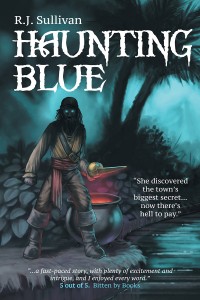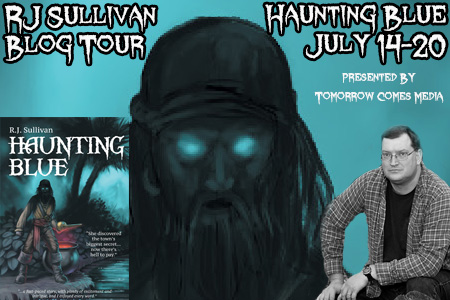Virtual Tour
Author: RJ Sullivan
Featured Book: Haunting Blue

About RJ Sullivan: Haunting Blue is the first book of the adventures of punk girl Fiona “Blue” Shaefer. This is the 2014 revised edition by Seventh Star Press. Seventh Star also released Haunting Obsession, a Rebecca Burton Novella, and Virtual Blue, the second book in Fiona’s tale. R.J.’s short stories have been featured in such acclaimed collections as Dark Faith: Invocations by Apex Books and Vampires Don’t Sparkle. His newest project is the Red Lotus series of science fiction novelettes. R.J. resides in Heartland Crossing, Indiana. He drinks coffee from a Little Mermaid mug and is man enough to admit it. www.rjsullivanfiction.com
RJ's Top Ten Do s and Don't s for every writing project
Anyone intent on being a writer faces one basic challenge:
Produce words and do so with some schedule and regular output. Any writer with
any success at completing projects eventually develops a system that works for
them.
The emphasis is on "for them." Ask ten writers,
and you'll get ten answers, all as varied and quirky as the individuals you
ask. But there is something to learn and pick up from each list, and so, for
what it's worth, I'll pass along ten habits, methodologies, and motivations
that keep me producing/, even when the muse has wandered off, as she tends to
do for part of every project.
1. Do outline.
2. Don't let the outline be the boss.
Some writers plot in great detail (plotters) and some
write seat-of-the-pants (pantsers). I am one of that third group called
"plantsers". I create a basic outline, what I think of as a
"story hanger," upon which I layer the details like sets of clothes.
As I write, I leave myself open to the moment.
It's an odd thing if you are not a writer, to hear that
writer's characters "talk" to them while they draft. but it's absolutely true. Let/'s ignore the
psychological implications for a moment and accept this as a given. I may have
an outline point about my punk girl "Blue" Shaefer interacting with
her boyfriend "Chip" along the lines of "Blue supports Chip's idea." Then
when the moment comes to write the scene, Blue starts protesting in my head
along the lines of:"I do NOT support that idea, and here's why."
A writer needs to play those moments out. In such situations,
I always let Blue air out her objection and then let Chip respond. And I write
the discussion out on the page in dialog form. That's where the magic happens. On rare occasions, I may delete a
lot of it, but more often, those become the moments where my characters are
most believable.
3. Do keep a schedule and word count.
4. Don't deny yourself when life happens.
So on the one hand, there is nothing more important that
keeping a weekly writing schedule. Why weekly? Because I have two writing-based
careers, there are days the fiction has to be put aside for my business
writing. So when I have a fiction project, I aim to find four days of the week
to write. I can do 1K words on a slow day; much more on a good day, so I set a
minimal goal of 1k words if I open a story file, or 4k for the week. I need to
credit A.D. Adams for helping me rethink this.
Important: Set
your daily goal based on your
average, not mine. Your daily count will go up as you gain experience, but set yourself
up to succeed. If 500 words is a good day, then aim for 2k a week. If you are
clearing 3K with regularity, then you can adjust. If you can do 3K before
breakfast, then set your daily goal accordingly. (Also, I hate you. Sorry,
where was I?)
Now, I want to emphasize one more time that it's
important to keep your schedule. But when you are well into a story, and the
kids want to go to the park, or catch a movie, or the spouse calls for a date
lunch, or it just looks like a good day for a picnic...or if you're me and you
just need a Star Trek episode mental break...don/'t deny those moments we call
life. The kids are only young once, conversation is a good thing, some days it
rains and snows, and the writing will be there when you get back. Plus--and I
find this is true every time--a two hour break results in a fresh mind when you
return, and you'll more than make up for it in the last part of the day.
5. Don't stop when you hit a block.
6. Do bribe yourself to get it done.
So I get three or four hundred words into my daily count.
I haven't really stopped, but the drafting is a chore, like slogging through
mud. But I have 700 words to go, and truthfully, any writer of any experience
can put down 700 words in several hours (this blog post is hitting 700 as I
type). So then I make plans to hit the
grocery store and get a chocolate bar, or pop on a favorite movie or TV show.
And I'm still going to do those things.
But not until I write my thousand words. Of course, that's all about self-discipline
and integrity, and that's another discussion. But bottom line, I dangle the
carrot of the day. And that I will get that carrot...AFTER I hit my word count.
And sure, it may take a couple of hours of pushing on, but I hit it, and then
reward myself.
7. DO keep writing as long as you're "in the
zone"
8. DON'T lose that momentum before you stop.
The first part is a no-brainer. The words are flying out,
and you can't help yourself. You hit 1.5K words and you have over half your day
left. Well, go, writer, go, ride that wave, set a new goal for today. Hit 3K,
go for 5K if your that good. Those days can never be counted on and you should
always take full advantage of them.
The second bit of advice I first heard from the awesome Gary
Braunbeck. It is entirely counter-intuitive but I am here to tell you it
absolutely works. His advice was: end your session in mid-thought, literally in
mid-sentence, when you know exactly where you want to go. Just stop typing and
close the file. The reason, he explained, is that when you come back the next
session and read the last few sentences, your mind picks up the flow of where
it was, and you come into your session strong. I was skeptical, but I have
applied this for several months now and it works! It starts your session "hot"
and gives you momentum to build on.
9. Don't get hung up on rewriting
10. DO edit as you go--every few chapters.
For a writer, nothing will freeze a hot streak faster
than trying to edit as you go. You can spend one session writing a scene and
the next two sessions re-writing that same scene. The result, inevitably, is
questioning your talent and ability because the story wants to get out while
you dissect word choice and minutiae. Drafting and editing are two different
mindsets. As many writers more talented than I have said, you have to
"give yourself permission to be bad" and just draft.
That said, when I have four or five chapters that have
sat for a few weeks (long enough that you can see them with a fresh mind--your
mileage may vary) I do re-read three to five chapters in a single session to
clean up some of the more egregious errors. I find that a good editing session
every four or five days enhances my feeling that I'm making progress.
So...these are the ten Do s and Don't s that keep RJ Sullivan
producing. Maybe something here will help you, maybe none of it. The important
thing about writers is not how we
produce, but that we produce, and if
some of these tips help you, terrific. If so, send me a note and tell me.
copybob@sbcglobal.net I'd love to hear from you.
Thanks to Deal-Sharing Aunt for letting me guest-blog
today.

Haunting Blue Book Synopsis: Punk, blue-haired “Blue” Shaefer, is at odds with her workaholic single mother. Raised as a city girl in a suburb of Indianapolis, Blue must abandon the life she knows when her unfeeling mother moves them to a dreadful small town. Blue befriends the only student willing to talk to her: computer nerd “Chip” Farren. Chip knows the connection between the rickety pirate boat ride at the local amusement park and the missing money from an infamous bank heist the townspeople still talk about. When Blue helps him recover the treasure, they awaken a vengeful ghost who’ll stop at nothing--not even murder--to prevent them from exposing the truth behind his evil deeds. Haunting Blue is Book One of the Adventures of Blue Shaefer
Author Links:
Website: http://rjsullivanfiction.com/
Facebook: https://www.facebook.com/R.J.SullivanAuthor
Goodreads: http://www.goodreads.com/author/show/5199299.R_J_Sullivan
Twitter: https://twitter.com/rjsullivanauthr
Tour Schedule and Activities
7/14 Jess Resides Here Interview
7/14 Beauty in Ruins Guest Post
7/14 fuonlyknew ~ Laura's ramblins and reviews Top Tens List
7/15 Deal Sharing Aunt Top Ten’s List
7/15 John F. Allen Writer Character Post
7/15 Armand Rosamilia, Horror Author Guest Post
7/16 The Rage Circus Vs. The Soulless Void Review
7/16 SpecMusicMuse Interview
7/16 Workaday Reads Post on Artwork of Haunting Blue
7/16 I Smell Sheep Character Post
7/17 Bee's Knees Review Review
7/17 Library Girl Reads & Reviews Guest Post
7/17 Come Selahway With Me Guest Post
7/18 A Haunted Head Author Interview
7/19 Nerd With A View Top Tens Post
7/19 Coffintree Hill Guest Post
7/20 Willow's Author Love Review
Tour Page URL: http://www.tomorrowcomesmedia.com/r-j-sullivans-haunting-blue-virtual-tour/
Amazon Links for Haunting Blue:
Kindle Version: http://www.amazon.com/Haunting-Blue-Adventures-Shaefer-Book-ebook/dp/B00KNC2Q34
Print Version: http://www.amazon.com/Haunting-Blue-R-J-Sullivan/dp/1941706053

No comments:
Post a Comment